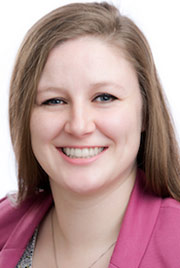Gardening: Small choices make a big difference
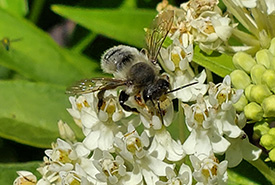
Megachile (leafcutter, mortar, and resin) bee on swamp milkweed (Photo by Sarah Ludlow)
Well, it is that time of year again — when the hope of spring and warmer temperatures is edging ever closer, especially in my home province of Saskatchewan. It is also the time when I begin starting my seeds to plant in my garden this upcoming year. In addition to planting the vegetable seeds for the edible plants that will populate my vegetable garden, I also start flower seeds. I’m sure you’ve heard by now that planting flowers, especially ones that are native to the area where you live, is one of the best ways to help bees and other pollinators in your backyard. Insects form the base of the food chain and a garden full of invertebrate life will also provide resources for larger wildlife, like birds.
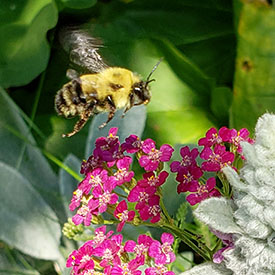
Bumblebee with yarrow (Photo by Sarah Ludlow)
Last summer, we dug out a small corner of our front lawn and planted it with flowers. Lawns can be deserts for biodiversity, lacking both food and places to live, and they are often managed in a way that is actively detrimental to wildlife (e.g., pesticides). Also, since lawns are often planted with the same few grass species that originated in Eurasia, they are often not adapted to the Canadian landscape where they get planted. As a result, lawns require a lot of watering and fertilizing to keep them green. So, this is why we began ripping out our lawn last summer. We started small to keep it manageable, and plan to expand our little flower patch this year.
Making a difference from your backyard
Much research shows that even though your urban backyard or garden is small, it can have big effects for conservation, and the largest impacts come when many people participate and, as a result, create connected habitat patches rather than islands for biodiversity. This means that your gardening and landscaping choices matter and what you choose to plant (or not plant, in some cases) makes a difference for pollinators, wildlife and conservation.
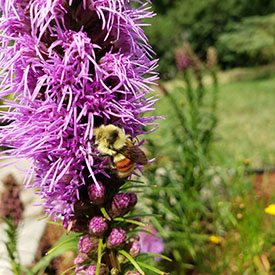
Hunt's bumblebee visiting liatris (Photo by Sarah Ludlow)
A quick look at the back of a package of “wildflower” seeds will tell you if it contains plant seeds that are invasive weeds in your area, and you can instead buy one that won’t contribute to the spread of invasive species. Similarly, choosing to grow plants that are single flowers, with fewer petals, rather than doubles will provide more food for pollinators. Double flower varieties are often bred for their aesthetic value, containing many more petals, but may be deficient in nutrients for pollinators and more difficult for them to access the pollen or nectar.
You don’t need to have a massive backyard or hectares of space to grow food for wildlife or for yourself; there are many varieties of flowers and vegetables that can be grown successfully in containers that can be placed on your balcony or front step. Another thing to consider is ensuring that the flowers you plant bloom for the entire growing season, which ensures that there is always food available for bees, butterflies and other pollinators.
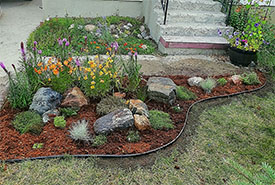
Lawn conversion to flower bed (Photo by Sarah Ludlow)
Finally, the last example is the from my own story: consider converting a portion of your lawn to flowers so that they can provide habitat. And remember that the plants that evolved on the landscape you call home (native plants) are the ones best adapted to those growing conditions and the ones most needed by your local wildlife.
So, this year, my hope is that you will consider your planting choices, as even these seemingly small acts can make a big difference!
Additional Resources
- Check out these regional planting guides for lists of plants native to where you live.
- Participate in community science projects like iNaturalist to document the wildlife species in your backyard or garden.
- Join NCC’s Small Acts of Conservation challenge.

